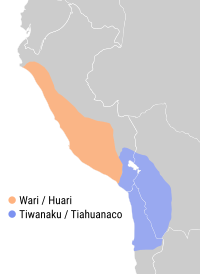
Photo from wikipedia
Simple yet extensive landscape modifications made past agrarian societies resilient to climate change. Archaeological research suggests significant human occupation in the arid Andean highlands during the 13th to 15th centuries,… Click to show full abstract
Simple yet extensive landscape modifications made past agrarian societies resilient to climate change. Archaeological research suggests significant human occupation in the arid Andean highlands during the 13th to 15th centuries, whereas paleoclimatic studies reveal prolonged drier and colder conditions during that period. Which subsistence strategy supported local societies in this harsh environment? Our field and aerial surveys of archaeological dwelling sites, granaries, and croplands provide the first evidence of extended pre-Hispanic agriculture supporting dense human populations in the arid Andes of Bolivia. This unique agricultural system associated with quinoa cultivation was unirrigated, consisting of simple yet extensive landscape modifications. It relied on highly specific environmental knowledge and a set of water-saving practices, including microterracing and biennial fallowing. This intense agricultural activity developed during a period of unfavorable climatic change on a regional and global scale, illustrative of efficient adaptive strategies to cope with this climatic change.
Journal Title: Science Advances
Year Published: 2017
Link to full text (if available)
Share on Social Media: Sign Up to like & get
recommendations!